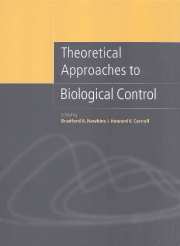Book contents
- Frontmatter
- Contents
- List of contributors
- Preface
- Part I Biological control theory: past and present
- 1 The theoretical foundations of biological control
- 2 Recent developments in theory for biological control of insect pests by parasitoids
- 3 Models in biological control: a field guide
- Part II Ecological considerations
- Part III Spatial considerations
- Part IV Genetic/evolutionary considerations
- Part V Microbes and pathogens
- Index
2 - Recent developments in theory for biological control of insect pests by parasitoids
from Part I - Biological control theory: past and present
Published online by Cambridge University Press: 13 August 2009
- Frontmatter
- Contents
- List of contributors
- Preface
- Part I Biological control theory: past and present
- 1 The theoretical foundations of biological control
- 2 Recent developments in theory for biological control of insect pests by parasitoids
- 3 Models in biological control: a field guide
- Part II Ecological considerations
- Part III Spatial considerations
- Part IV Genetic/evolutionary considerations
- Part V Microbes and pathogens
- Index
Summary
Introduction
Historically, most models of insect–parasitoid interactions have been framed in terms of systems of difference equations of the Nicholson–Bailey type. These have been extensively reviewed by Hassell (1978), May & Hassell (1988), and Jones et al. (1994). Berryman (Chapter 1) explores the structure of discrete-time models of various types. Although the discrete-time framework of these models is consistent with the discrete generation natural history of a number of temperate insect systems, they are less appropriate for many pest species that can have a number of overlapping generations within a year. They are further limited by the fact that only the net effect, summed up over the year, of all of the processes affecting the species within the year can be included in the equations. This results in rather abstract models in which it is difficult to include explicitly specific behavioral or physiological mechanisms.
In this chapter we will concentrate on continuous-time models of host–parasitoid interactions that incorporate host stage-and parasitoid physiological state-dependent behaviors. We will discuss the utility of these types of models in comparing the predicted efficacy of different parasitoid species in biological control programs. We will discuss how models that incorporate within-season dynamics and parasitoid behaviors into discrete-time non-overlapping generations produce predictions that are not possible with standard discrete-time models. In much of the chapter we concentrate on the stability of, or types of dynamics produced by, the host–parasitoid interaction, because that was the focus of many of the models reviewed.
- Type
- Chapter
- Information
- Theoretical Approaches to Biological Control , pp. 22 - 42Publisher: Cambridge University PressPrint publication year: 1999
- 10
- Cited by



